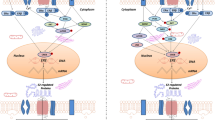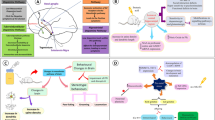Abstract
Rational
Depression is prevalent among women of childbearing age and is frequently treated with selective serotonin reuptake inhibitors (SSRIs). As some SSRIs, such as fluoxetine (Flx), can cross the placenta, it is possible that the neurodevelopment of the fetus may be affected, leading to altered behavior in adulthood.
Objectives
In this study, we examined the effects of perinatal Flx exposure on the subsequent expression of circadian rhythms in adult mice.
Methods
Dams were treated with 25 mg/kg/day Flx in their drinking water from embryonic day 15 to postnatal day 12. Circadian organization of wheel running rhythms and phase shifts to photic and non-photic stimuli were assessed in the offspring starting at 6 weeks of age.
Results
We found that perinatal Flx exposure led to larger light-induced phase advances (1.19 ± 0.51 vs. 0.55 ± 0.25 h), smaller phase advances to the serotonin agonist 8-OH-DPAT during the mid-subjective day (0.44 ± 0.15 vs. 0.70 ± 0.17 h), and a shorter free-running period in constant darkness (23.47 ± 0.13 vs. 23.64 ± 0.13 h).
Conclusions
These results suggest that perinatal exposure to SSRIs may have consequences for the functioning of the circadian system later in life.







Similar content being viewed by others
References
Andrade SE, Raebel MA, Brown J, Lane K, Livingston J, Boudreau D, Rolnick SJ, Roblin D, Smith DH, Willy ME, Staffa JA, Platt R (2008) Use of antidepressant medications during pregnancy: a multisite study. Am J Obstet Gynecol 198:194.e1–5
Antle MC, Mistlberger RE (2000) Circadian clock resetting by sleep deprivation without exercise in the Syrian hamster. J Neurosci 20:9326–9332
Antle MC, Marchant EG, Niel L, Mistlberger RE (1998) Serotonin antagonists do not attenuate activity-induced phase shifts of circadian rhythms in the Syrian hamster. Brain Res 813:139–149
Antle MC, Ogilvie MD, Pickard GE, Mistlberger RE (2003) Response of the mouse circadian system to serotonin 1A/2/7 agonists in vivo: surprisingly little. J Biol Rhythms 18:145–158
Bairy KL, Madhyastha S, Ashok KP, Bairy I, Malini S (2007) Developmental and behavioral consequences of prenatal fluoxetine. Pharmacology 79:1–11
Bebbington P, Dunn G, Jenkins R, Lewis G, Brugha T, Farrell M, Meltzer H (2003) The influence of age and sex on the prevalence of depressive conditions: report from the National Survey of Psychiatric Morbidity. Int Rev Psychiatry 15:74–83
Bennett HA, Einarson A, Taddio A, Koren G, Einarson TR (2004) Prevalence of depression during pregnancy: systematic review. Obstet Gynecol 103:698–709
Bobrzynska KJ, Mrosovsky N (1998) Phase shifting by novelty-induced running: activity dose–response curves at different circadian times. J Comp Physiol A 182:251–258
Bobrzynska KJ, Vrang N, Mrosovsky N (1996) Persistence of nonphotic phase shifts in hamsters after serotonin depletion in the suprachiasmatic nucleus. Brain Res 741:205–214
Cabrera TM, Battaglia G (1994) Delayed decreases in brain 5-hydroxytryptamine 2A/2C receptor density and function in male rat progeny following prenatal fluoxetine. J Pharmacol Exp Ther 269:637–645
Cabrera-Vera TM, Battaglia G (1998) Prenatal exposure to fluoxetine (Prozac) produces site-specific and age-dependent alterations in brain serotonin transporters in rat progeny: evidence from autoradiographic studies. J Pharmacol Exp Ther 286:1474–1481
Cabrera-Vera TM, Garcia F, Pinto W, Battaglia G (1997) Effect of prenatal fluoxetine (Prozac) exposure on brain serotonin neurons in prepubescent and adult male rat offspring. J Pharmacol Exp Ther 280:138–145
Capello CF, Bourke CH, Ritchie JC, Stowe ZN, Newport DJ, Nemeroff A, Owens MJ (2011) Serotonin transporter occupancy in rats exposed to serotonin reuptake inhibitors in utero or via breast milk. J Pharmacol Exp Ther 339:275–285
Clancy B, Finlay BL, Darlington RB, Anand KJ (2007) Extrapolating brain development from experimental species to humans. Neurotoxicology 28:931–937
Cooper WO, Willy ME, Pont SJ, Ray WA (2007) Increasing use of antidepressants in pregnancy. Am J Obstet Gynecol 196:544.e1–5
Gardani M, Biello SM (2008) The effects of photic and nonphotic stimuli in the 5-HT7 receptor knockout mouse. Neuroscience 152:245–253
Gouvea TS, Morimoto HK, de Faria MJ, Moreira EG, Gerardin DC (2008) Maternal exposure to the antidepressant fluoxetine impairs sexual motivation in adult male mice. Pharmacol Biochem Behav 90:416–419
Hiemke C, Hartter S (2000) Pharmacokinetics of selective serotonin reuptake inhibitors. Pharmacol Ther 85:11–28
Horikawa K, Shibata S (2004) Phase-resetting response to (+)8-OH-DPAT, a serotonin 1A/7 receptor agonist, in the mouse in vivo. Neurosci Lett 368:130–134
Karpova NN, Lindholm J, Pruunsild P, Timmusk T, Castrén E (2009) Long-lasting behavioural and molecular alterations induced by early postnatal fluoxetine exposure are restored by chronic fluoxetine treatment in adult mice. Eur Neuropsychopharmacol 19:97–108
Lee LJ (2009) Neonatal fluoxetine exposure affects the neuronal structure in the somatosensory cortex and somatosensory-related behaviors in adolescent rats. Neurotox Res 15:212–223
Lee L-J, Lee LJ-H (2012) Neonatal fluoxetine exposure alters motor performances of adolescent rats. Dev Neurobiol 72:1122–1132
Lisboa SF, Oliveira PE, Costa LC, Venancio EJ, Moreira EG (2007) Behavioral evaluation of male and female mice pups exposed to fluoxetine during pregnancy and lactation. Pharmacology 80:49–56
Liu D, Diorio J, Tannenbaum B, Caldji C, Francis D, Freedman A, Sharma S, Pearson D, Plotsky PM, Meaney MJ (1997) Maternal care, hippocampal glucocorticoid receptors, and hypothalamic–pituitary–adrenal responses to stress. Science 277:1659–1662
Marchant EG, Watson NV, Mistlberger RE (1997) Both neuropeptide Y and serotonin are necessary for entrainment of circadian rhythms in mice by daily treadmill running schedules. J Neurosci 17:7974–7987
Marston OJ, Williams RH, Canal MM, Samuels RE, Upton N, Piggins HD (2008) Circadian and dark-pulse activation of orexin/hypocretin neurons. Mol Brain 1:19
Mendes-da-Silva C, de Souza SL, Barreto-Medeiros JM, de Freitas-Silva SR, Antunes DE, Cunha AD, Ribas VR, de Franca MF, Nogueira MI, Manhaes-de-Castro R (2002) Neonatal treatment with fluoxetine reduces depressive behavior induced by forced swim in adult rats. Arq Neuropsiquiatr 60:928–931
Mistlberger RE, Antle MC, Glass JD, Miller JD (2000) Behavioral and serotonergic regulation of circadian rhythms. Biol Rhythm Res 31:240–283
Morin LP (1999) Serotonin and the regulation of mammalian circadian rhythmicity. Ann Med 31:12–33
Morin LP, Allen CN (2006) The circadian visual system, 2005. Brain Res Rev 51:1–60
Morin LP, Blanchard J (1991) Depletion of brain serotonin by 5,7-DHT modifies hamster circadian rhythm response to light. Brain Res 566:173–185
Nagano M, Liu M, Inagaki H, Kawada T, Suzuki H (2012) Early intervention with fluoxetine reverses abnormalities in the serotonergic system and behavior of rats exposed prenatally to dexamethasone. Neuropharmacology 63:292–300
Olivier JD, Valles A, van Heesch F, Afrasiab-Middelman A, Roelofs JJ, Jonkers M, Peeters EJ, Korte-Bouws GA, Dederen JP, Kiliaan AJ, Martens GJ, Schubert D, Homberg JR (2011) Fluoxetine administration to pregnant rats increases anxiety-related behavior in the offspring. Psychopharmacology (Berl) 217:419–432
Paulus EV, Mintz EM (2012) Developmental disruption of the serotonin system alters circadian rhythms. Physiol Behav 105:257–263
Penev PD, Turek FW, Zee PC (1995) A serotonin neurotoxin attenuates the phase-shifting effects of triazolam on the circadian clock in hamsters. Brain Res 669:207–216
Pickard GE, Smith BN, Belenky M, Rea MA, Dudek FE, Sollars PJ (1999) 5-HT1B receptor-mediated presynaptic inhibition of retinal input to the suprachiasmatic nucleus. J Neurosci 19:4034–4045
Popa D, Lena C, Alexandre C, Adrien J (2008) Lasting syndrome of depression produced by reduction in serotonin uptake during postnatal development: evidence from sleep, stress, and behavior. J Neurosci 28:3546–3554
Prosser RA (2000) Serotonergic actions and interactions on the SCN circadian pacemaker: in vitro investigations. Biol Rhythm Res 31:315–339
Prosser RA (2003) Serotonin phase-shifts the mouse suprachiasmatic circadian clock in vitro. Brain Res 966:110–115
Rampono J, Simmer K, Ilett KF, Hackett LP, Doherty DA, Elliot R, Kok CH, Coenen A, Forman T (2009) Placental transfer of SSRI and SNRI antidepressants and effects on the neonate. Pharmacopsychiatry 42:95–100
Rea MA, Pickard GE (2000) Serotonergic modulation of photic entrainment in the Syrian hamster. Biol Rhythm Res 31:284–314
Rea MA, Barrera J, Glass JD, Gannon RL (1995) Serotonergic potentiation of photic phase shifts of the circadian activity rhythm. Neuroreport 6:1417–1420
Renwick AG (2000) The use of safety or uncertainty factors in the setting of acute reference doses. Food Addit Contam 17:627–635
Romijn HJ, Hofman MA, Gramsbergen A (1991) At what age is the developing cerebral cortex of the rat comparable to that of the full-term newborn human baby? Early Hum Dev 26:61–67
Rosenwasser AM, Dwyer SM (2001) Circadian phase shifting: relationships between photic and nonphotic phase-response curves. Physiol Behav 73:175–183
Silva CM, Goncalves L, Manhaes-de-Castro R, Nogueira MI (2010) Postnatal fluoxetine treatment affects the development of serotonergic neurons in rats. Neurosci Lett 483:179–183
Smart CM, Biello SM (2001) WAY-100635, a specific 5-HT1A antagonist, can increase the responsiveness of the mammalian circadian pacemaker to photic stimuli. Neurosci Lett 305:33–36
Smith VM, Sterniczuk R, Phillips CI, Antle MC (2008) Altered photic and non-photic phase shifts in 5-HT(1A) receptor knockout mice. Neuroscience 157:513–523
Smit-Rigter LA, Noorlander CW, von Oerthel L, Chameau P, Smidt MP, van Hooft JA (2012) Prenatal fluoxetine exposure induces life-long serotonin 5-HT3 receptor-dependent cortical abnormalities and anxiety-like behaviour. Neuropharmacology 62:865–870
Sterniczuk R, Stepkowski A, Jones M, Antle MC (2008) Enhancement of photic shifts with the 5-HT1A mixed agonist/antagonist NAN-190: intra-suprachiasmatic nucleus pathway. Neuroscience 153:571–580
Takatsuji K, Oyamada H, Tohyama M (1995) Postnatal development of the substance P-, neuropeptide Y- and serotonin-containing fibers in the rat suprachiasmatic nucleus in relation to development of the retino-hypothalamic projection. Brain Res Dev Brain Res 84:261–270
Tominaga K, Shibata S, Ueki S, Watanabe S (1992) Effects of 5-HT1A receptor agonists on the circadian rhythm of wheel-running activity in hamsters. Eur J Pharmacol 214:79–84
Whitaker-Azmitia PM, Druse M, Walker P, Lauder JM (1996) Serotonin as a developmental signal. Behav Brain Res 73:19–29
Yamakawa GR, Antle MC (2010) Phenotype and function of raphe projections to the suprachiasmatic nucleus. Eur J Neurosci 31:1974–1983
Ying SW, Rusak B (1994) Effects of serotonergic agonists on firing rates of photically responsive cells in the hamster suprachiasmatic nucleus. Brain Res 651:37–46
Ying SW, Rusak B (1997) 5-HT7 receptors mediate serotonergic effects on light-sensitive suprachiasmatic nucleus neurons. Brain Res 755:246–254
Zheng J, Xu DF, Li K, Wang HT, Shen PC, Lin M, Cao XH, Wang R (2011) Neonatal exposure to fluoxetine and fluvoxamine alters spine density in mouse hippocampal CA1 pyramidal neurons. Int J Clin Exp Pathol 4:162–168
Acknowledgments
This work was supported by NSERC Discovery Grants to RHD and MCA, a CIHR Operating Grant to RHD, postgraduate fellowships from NSERC to VK and VMS, and postgraduate fellowships from Alberta Innovates Health Solutions and the Killam Trusts to VMS. The authors declare that they have no conflicts of interest.
Author information
Authors and Affiliations
Corresponding author
Rights and permissions
About this article
Cite this article
Kiryanova, V., Smith, V.M., Dyck, R.H. et al. The effects of perinatal fluoxetine treatment on the circadian system of the adult mouse. Psychopharmacology 225, 743–751 (2013). https://doi.org/10.1007/s00213-012-2861-3
Received:
Accepted:
Published:
Issue Date:
DOI: https://doi.org/10.1007/s00213-012-2861-3




